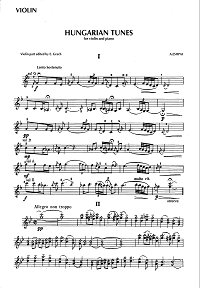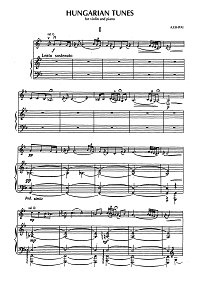Eshpai - Hungarian tunes for violin and piano
Eshpai - Hungarian tunes for violin and piano. You can download the PDF sheet music Eshpai - Hungarian tunes for violin and piano on this page. “Hungarian Tunes” is a rhapsody for violin and orchestra; It was written when Eshpay studied at the fourth year of the Conservatory, and it was first performed by Edward Grach, accompanied by the author. The writing became popular immediately after its first performance - it was premiered at the IVth World Festival of Youth and Students in Bucharest (1953), then in Warsaw at the Vth World Festival (1955), where it was awarded the first prize at the competition of young composers. The work of A. Eshpai pleases with bright colorful, richness and real artistic temperament with an excellent orchestral sound. Possessing a great natural sense of harmony and orchestral color, Eshpai skillfully uses these expressive means in his scores - fascinating, full of dynamics and emotional tension.
To download PDF, click the "Download PDF" button below the appropriate sheet music image.
To view the first page of Eshpai - Hungarian tunes for violin and piano click the music sheet image. |
| PDF format sheet music |
|
|
|
Violin part: 8 pages. 921 K
|
Piano part: 20 pages. 1750 K
|
 |
 |
|
|
| Download PDF (14.99
€) |
Download PDF (14.99
€) |
|
The score of "Hungarian Tunes" is distinguished by a variety of timbre combinations, transparency, a complete lack of viscosity and heaviness, the organic nature of orchestral development. Intended for violin solo and orchestra, this composition was a kind of preparation for the Violin Concerto; it is more modest in scale and, at the same time, differs by a great variety in details. The violin part is inventive and simple; nowhere in conflict with the nature of the instrument, the composer extracts the most unexpected timbre effects from it: the violin sounds like a flute, then like a harp.
Another important feature of the “Hungarian tunes” is the captivating play of rhythms that are Mari-Hungarian in origin. The basis for the rhythmic variation was already given by the folk melodies themselves, exceptionally richly ornamented. Elastic-dance, recitative-improvisational, song - they all differ in energy and liveliness of rhythmic development.
Parts of "Hungarian Tunes" are diverse in nature. So, the basis of the second part is the exquisite dance of the solo violin. The rapid movement of the dance theme of the fourth part. Another dance is the theme of the fifth part, resembling a graceful ballet intermezzo, but also featuring signs of folk dance. The finale begins with the dance theme. |
|